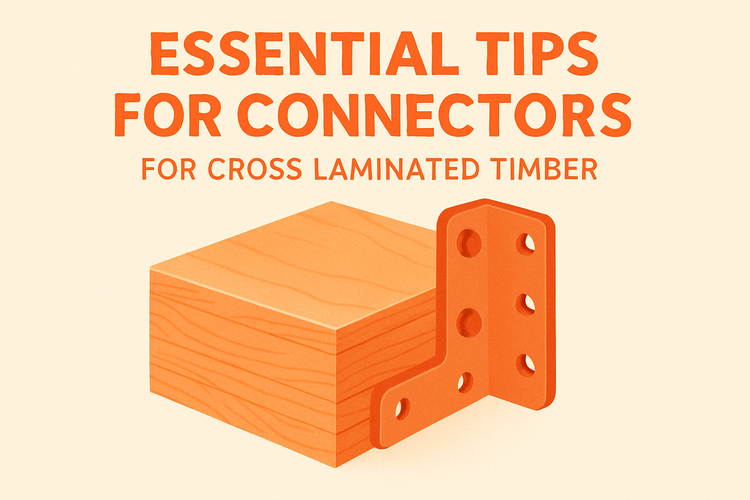Essential Tips For Connectors For Cross Laminated Timber

Understanding Load Paths and Structural Requirements
When working with cross laminated timber (CLT), it's essential to comprehend how loads are transferred through the structure. Proper planning ensures optimal use of connectors.
Knowing the load paths allows installers and engineers to choose the correct types and sizes of connectors. For instance, tension, compression, and lateral forces each require suitable hardware to maintain structural integrity. In projects involving connectors for cross laminated timber, precise selection enhances both performance and longevity. Common errors such as undersized fasteners or poorly placed brackets can lead to premature wear or even failure under load conditions.
Structural requirements also depend heavily on local building codes and the design intent. Using engineered products such as joist hangers can help distribute loads more consistently while simplifying installation. As CLT elements are often prefabricated, ensuring that the connector layout aligns with the structure during the design phase prevents costly adjustments onsite.
Selection of Connector Type Based on Function
Different tasks require different connector types. Understanding what each connector is designed to do is vital when working with CLT.
For example, post base connectors are ideal for applications where lift or moisture control is a concern, such as securing vertical members off the ground. On the other hand, angle brackets offer reinforcement at critical junctions, especially where panels intersect at right angles. CLT's dimensional stability means the connectors used do not have to accommodate shrinkage, but they do need to support the inherent loads without compromise.
Choosing connectors that complement the fire-resistance and acoustic characteristics of CLT is also vital, especially in multi-storey or public-use buildings. When used appropriately, purpose-built connectors ensure that these properties are not diminished after installation.
Both aesthetics and functionality matter. Many modern connector systems for CLT are designed to be either concealed or highly refined, ensuring architectural intent is preserved while offering secure anchorage and performance.
Importance of Fasteners and Fixing Patterns
Simply using the right connector isn't enough; fasteners and their configuration make a big difference.
CLT panels require specific approaches for fixing to prevent splitting or over-penetration. Common fasteners used include long screws that are designed to engage multiple layers of laminated timber. Many screws and nails are manufactured with coatings that enhance withdrawal resistance and corrosion protection, both crucial in exposed or semi-exposed applications.
The fixing pattern — that is, the placement and spacing of each fastener — has a direct impact on load-bearing and vibration damping. Incorrect patterns can weaken a joint despite the use of quality hardware. For those using timber frame connectors, following manufacturer specifications ensures compliance and reduces liability over time.
Employing a diagonal or staggered pattern in screw applications can help distribute stresses more evenly. This is especially beneficial in seismic zones or areas subject to high winds, as stress on any individual fastener is significantly reduced.
Durability and Weather Resistance Considerations
Cross laminated timber may be stable, but connectors are often the most vulnerable point in aggressive environments such as coastal areas or industrial zones.
Choosing weather-resistant hardware — especially stainless or galvanised finishes — is crucial for long-term performance. Exposure to moisture, temperature fluctuation, and chemical agents can degrade untreated metals quickly, compromising structural safety. Hardware like high wind ties & timber connectors are specifically designed for use in challenging conditions, improving resilience without extra installation complexity.
In cases where CLT is visible in exterior settings, hidden fastening systems or sealed connectors not only improve aesthetics but also mitigate corrosion. It’s essential to maintain barrier protection between dissimilar materials to prevent galvanic action, which can degrade connectors prematurely. Applying bitumen tape or site-specific sealants can aid in moisture management.
Manufacturer warranties often require specific installation and material guidelines be followed. Always cross-reference these with the environmental conditions of your site to ensure compliance and qualify for product guarantees.
Site Preparation and Installation Guidelines
Before fixing any connectors, verify that all panels and frameworks are aligned and dry.
CLT panels must be installed on stable, level surfaces to prevent stress buildup at connector points. Ensuring consistent spacing, plumb walls, and proper anchorage points reduces error rates and minimises on-site modifications. Pre-drilled holes, marking templates, or laser measurement tools can streamline this phase, particularly when working with concealed roof connectors or multi-angle junctions.
Proper lifting and positioning equipment must be used to avoid panel damage during movement. CLT materials are heavy, making them sensitive to point loads and impact forces. With accurate hoisting, connector alignment is more precise, which saves both time and materials. Safety protocols — such as edge protection or fall restraint when working at heights — are a must.
Finally, once connectors are installed, double-check tightness, alignment, and embedment depth. Poorly installed screws or brackets are common failure points, making early checks essential before proceeding to the next construction phase.
